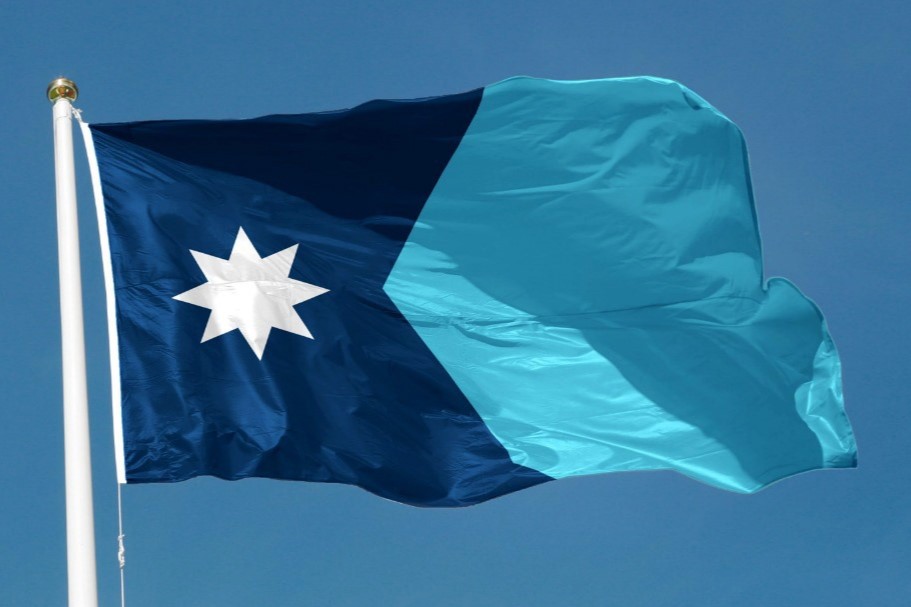
Why are counties, GOP pushing against the Minnesota state flag and seal?
With Minnesota poised to officially adopt a new state flag and seal, some counties are passing resolutions opposing the new symbols and Republicans have pushed to make the change into a bigger political issue.
At least five counties across Minnesota have voted to formally complain about the new state symbols, raising issues about what they call unfunded mandates. And just a few weeks ago, the state Republican Party launched a website with a petition to reject the new flag, saying it erases state history.
The new state flag and seal come after decades of calls for change. Minnesota’s current flag includes the state seal against a blue background. The seal depicts a Native American riding off into the sunset while a white settler plows his field with his rifle leaning on a nearby stump.
The current version of Minnesota’s state seal was adopted in 1983, though it has its roots before statehood in 1858. (Courtesy of the State Emblems Redesign Commission)
Many found the imagery offensive because of its depiction of white settlers displacing the state’s original inhabitants, and to boot the design was seen as overcomplicated and unoriginal as it resembled many other state flags.
There is some political disagreement over whether the flag and seal are necessary, but counties also have had practical questions about when they’ll have to adopt the new symbols and how much it will cost.
Confusion among some counties
Flags are more or less an afterthought for counties when considering replacement expenses.
The biggest cost so far appears to come from law enforcement. Many sheriff’s departments incorporate the soon-to-be-gone state seal into their logos, meaning car decals, badges and letterheads will have to be replaced.
That’s the biggest question local governments have so far about the new flag and seal, though they’re under no requirement to make the changes immediately when the new symbols take effect, says Matt Hilgart, government relations manager with the Association of Minnesota Counties.
“Most of it that, what I’ve seen is just the concern about in the illusion that they’re under some kind of mandate to change everything that they have now, and that they’re very concerned with the costs,” he said, adding he hasn’t heard members say they are passing the resolutions purely to go against what’s coming out of the Capitol.
“I’m not hearing, you know, ‘I hate this flag and I’m gonna let St. Paul know I hate it,’” Hilgart said.
County opposition
In the past month, five counties outside the Twin Cities metro have passed resolutions against the flag. Though so far, none have said they’ll outright reject the flag and seal and hold on to the old one — though there isn’t anything in the law stopping them from doing so.
Crow Wing, Douglas, Houston, McLeod and Nobles counties approved measures criticizing the process that led to the new flag and the new expenses. Fillmore County sent a letter to state officials over their concerns with the new state symbols.
On Dec. 12, 2023, the State Emblems Redesign Commission voted to adopt design modifications to the official Great Seal of the State of Minnesota. Members of the commission picked their final designs from more than 2,600 public submissions in December, and barring intervention by the Legislature. Commission members who supported the measure say they think the whole state should have been brought into the process.
“That doesn’t seem fair to me … that should be voted on by their elected officials, or by the people,” said Eric Johnson, a Houston County commissioner.
On December 12, 2023, the State Emblems Redesign Commission voted to adopt design modifications to the official Great Seal of the State of Minnesota. The design is subject to further changes and final approval by the Commission. (Courtesy of the State Emblems Redesign Commission)
Expenses
In Houston County, the sheriff’s department expected it would cost about $32,000 to replace squad car decals and badges that incorporate the old state seal.
“That’s that’s the main reason why we’re pushing back on this — because this is this is going to be an unfunded mandate,” Johnson said.
Houston County has about 18,000 residents and an annual budget of about $14 million. In much bigger counties, officials have already estimated much higher costs for updating law enforcement equipment and other areas where state symbols appear. None have passed resolutions protesting the new state symbols.
Here’s a list of some counties with their cost estimates:
• Dakota County — Replacing state flags and seals in Dakota County will cost up to $170,000 when the new symbols go into effect, according to county spokesperson Mary Beth Schubert. Most of that cost is for the sheriff’s department, which expects to spend $140,000 to $150,000. Facilities officials expect to spend about $20,000.
• Hennepin County — Sheriff’s department symbols here incorporate the old state seal, and replacing uniforms will cost about $500,000, according to the sheriff’s office. That’s an initial estimate and does not include vehicles and other equipment. Replacing flags will cost about $300 per flag at seven different buildings, a county official said.
• St. Louis County — Officials here haven’t done a full tally of how much it’ll cost the county to replace its symbols. The St. Louis County Sheriff’s Office logo has the state seal at its center, and updating things like signage and badges would cost about $50,000 if it all had to happen at once, according to county spokesperson Dana Kazel.
• Ramsey County and Washington County didn’t have estimates as of late January.
Hilgart, with the county association, says his group has been telling members there is flexibility on adopting the new state symbols, and counties won’t be forced to do anything immediately.
Historic and cultural objections
Underlying budget concerns are some questions about the outgoing symbols’ significance to the state’s identity. Johnson, of Houston County, expressed a similar sentiment to what some GOP lawmakers and the Minnesota Republican Party have said.
“All those symbols on that flag are in honor of our heritage and our history of our state,” Johnson said.
In a statement launching a petition to keep the flag, Minnesota GOP Chairman David Hann and Deputy Chairwoman Donna Bergstrom had stronger words.
“The flag the DFL has eliminated was a version of the historic flag our regiments fought under during the Civil War,” they wrote. “Minnesota was the first state to offer troops to the Union cause in 1861, beginning a long tradition of leading the nation in confronting injustice. The DFL quest to erase our history is repugnant and should be rejected.”
Asked about the new flag design, Johnson first said he didn’t have an opinion, but later added of the minimalist blue and white design: “It’s pretty plain to me; it doesn’t really stand for much.”
What can opponents do?
There has been plenty of noise the past month over the new design, but besides firing up conservatives, what exactly can Republicans and any other officials who oppose the new flag and seal actually do?
On the legislative side? Not much.
Following the adoption of the new state symbols, Sen. Steve Drazkowski, R-Mazeppa, and Rep. Bjorn Olson, R-Fairmont, non-voting members of the redesign commission, said they wanted to put the new flag and seal up to a statewide vote, but Democratic-Farmer-Labor leaders in control of the Senate and House have no interest.
However, on the local government level, there may be more room for regional expression. The law that set the new flag and seal into motion only applies to the state of Minnesota and does not compel cities and counties to do the same.
But again, no counties have signaled they’d keep the old symbols. So far, their criticism has been about the process and cost.
Related Articles
Vadnais Heights lawmaker Brion Curran sentenced for driving while impaired
Letters: Experimenting with ways to use less road salt in Minnesota
Fire at offices of conservative organizations in Golden Valley under investigation as arson, ATF says
MN rebates checks will be taxed by federal government this year
White farmer sues Minnesota, alleging racial discrimination over grant program


